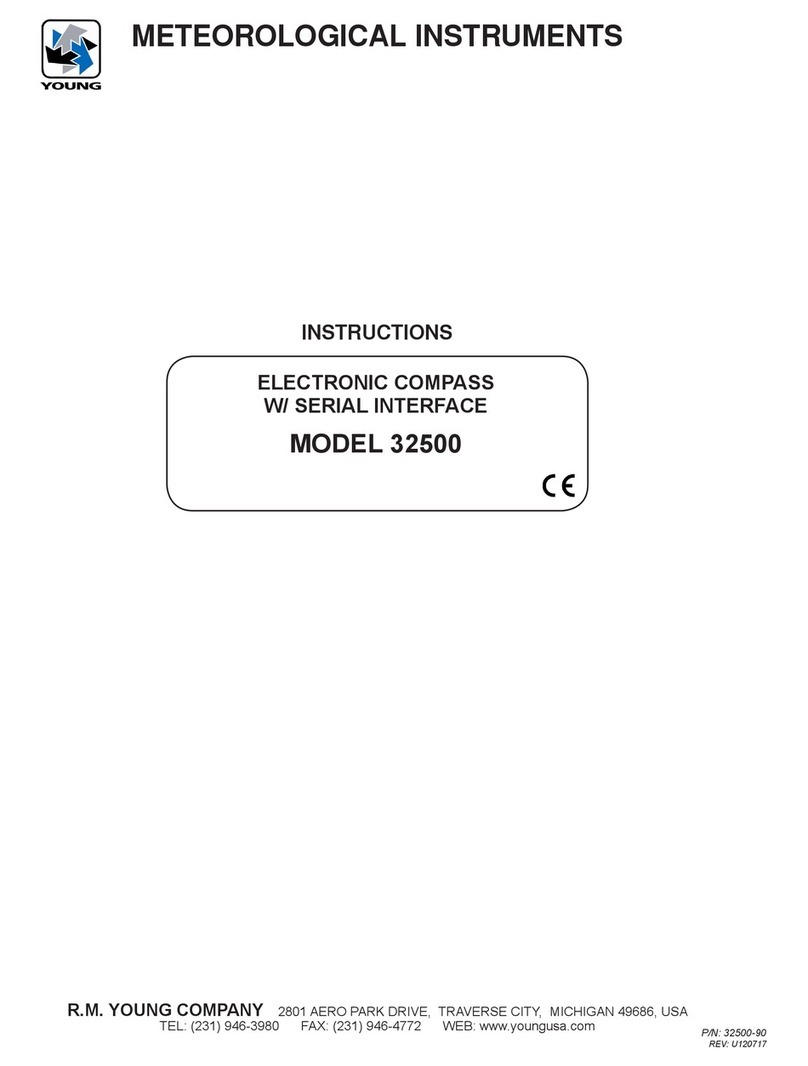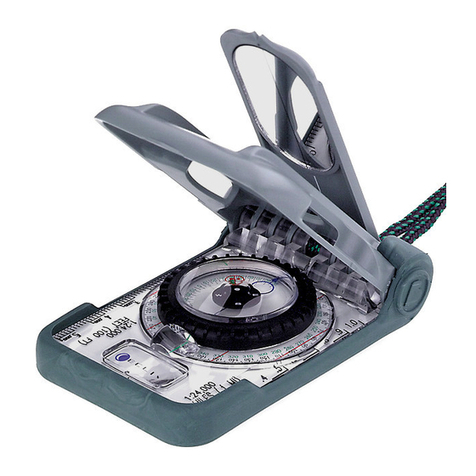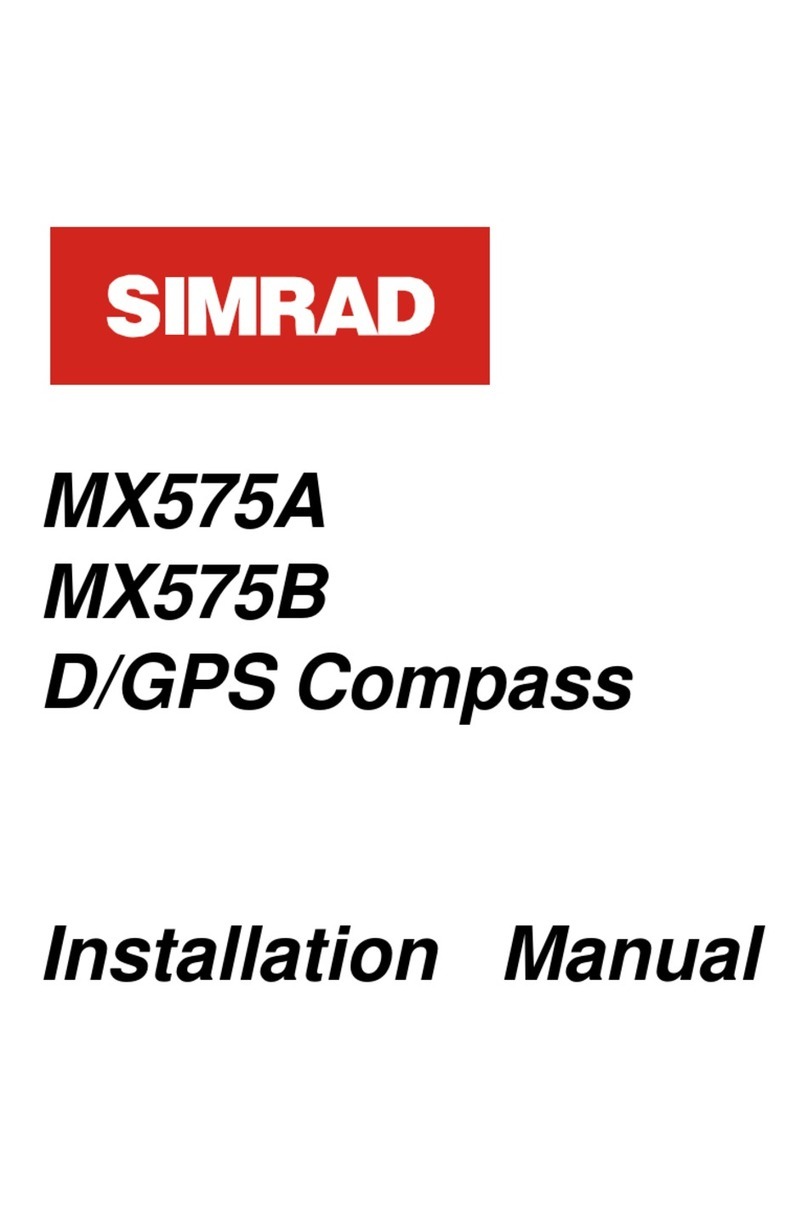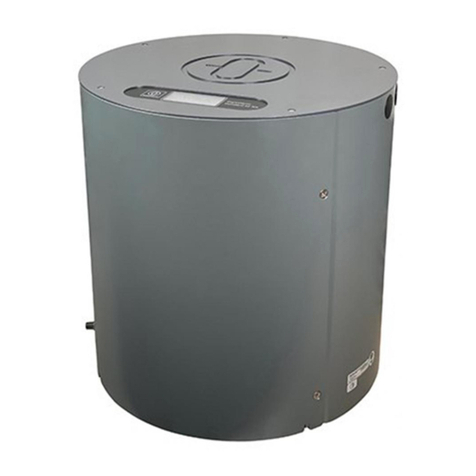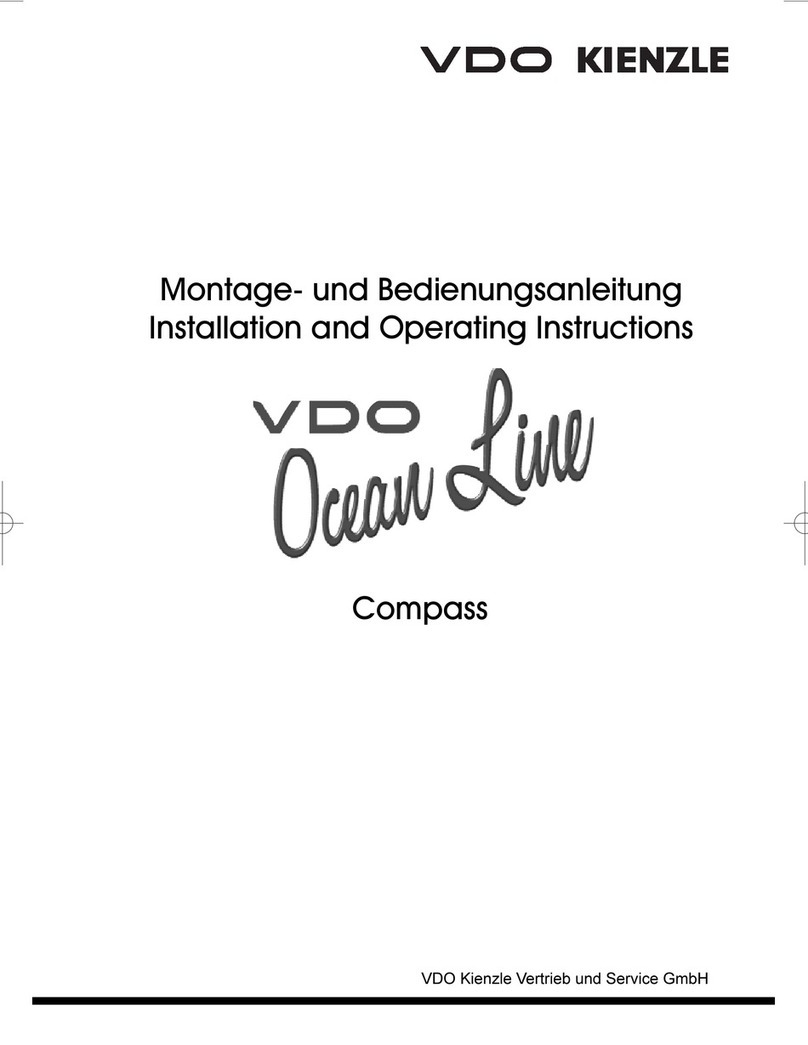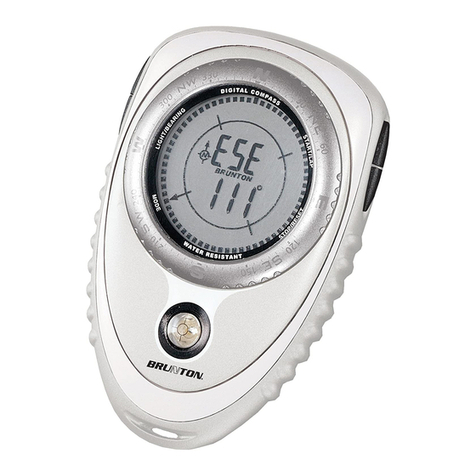R.M. Young 32500 User manual

MODEL 32500
ELECTRONICCOMPASS
REV K080703
MANUALPN 32500-90
R. M. YOUNG COMPANY
2801 AERO PARK DRIVE, TRAVERSE CITY, MICHIGAN 49686, USA
TEL: (231) 946-3980 FAX: (231) 946-4772

Page1
MODEL 32500
ELECTRONICCOMPASS
SPECIFICATIONS*
Compass:
Resolution: 0.5 degrees
Accuracy: ±2 degrees (rms)
Wind Speed Input:
Sensor Type: AC Frequency Generator
Sensitivity: 50mVp-pminimum
Range: 0-2000 Hz
Wind Direction Input:
Sensor Type: Potentiometer
Range: 0-5000mV = 0 to 355 degrees
Excitation: 5000mV (limited to 5 mA)
Voltage Inputs (Auxiliary Sensor Inputs):
VIN1and VIN2 0-1000mV
VIN3and VIN4 0-5000mV
Voltage Outputs:
OUT1 0-5000mV 0-100 m/s wind speed
OUT2 0-5000mV 0-360° true wind dir
(Uses compass meas-
urement to produce
true wind direction.)
Serial Output: Full duplex RS-232,
Half duplex RS-485 (25 mS switchover)
1200, 2400, 4800, and 9600 baud
8 data, 1 stop, no parity
Operating Temp: -50°C to 50°C
Power: 11 to 30 VDC, 40 mA
Mounting: 1 inch IPS (1.34 inch actual diameter)
Size: 4.75” (12cm) H
0.87” (7.3cm) W
2.12” (5.3cm) D *Specificationssubjecttochange
1.0INTRODUCTION
TheModel32500ELECTRONICCOMPASSmeasuresmagnetic
heading and incorporates auxiliary inputs to measure signals from
YOUNG sensors. Wind speed and direction sensors, temperature
and humidity sensors, barometers and other meteorological
instruments can connect directly to 32500 inputs. Two specialized
wind sensor inputs and four general purpose voltage inputs convert
measurements to high-resolution numerical values. Wind direction
input may be combined with compass readings to obtain true
direction.
Measurements are converted to RS-232 or RS-485 serial formats or
calibrated voltage outputs. Both continuous and polled outputs are
available. When polled, up to 16 units can be networked together. For
marine applications the 32500 produces standard NMEA output
sentences. Voltage output for wind speed and direction is available
when the 32500 is connected to a YOUNG wind sensor.
1.1INSTALLATION
The 32500 is supplied in a weather-resistant enclosure with a
mounting adapter that fits 1 inch IPS pipe (1.34 inch nominal
diameter). When used with the YOUNG Wind Monitor, the mounting
adapter engages the Wind Monitor orientation notch. Refer to the
WIRING DIAGRAM for electrical connection details and jumper
settings. Place jumpers to select desired output format. Once
installed, the compass must be calibrated to correct for local
magnetic distortions caused by nearby structures. To calibrate the
compass, follow the procedure outlined below.
1.2SETUP
Operating mode may be set with simple jumpers or customized with
software commands via serial connection. Settings are retained when
power is removed.
1.2.1 COMPASS CALIBRATION
1. Remove cover from compass. Press and hold CALIBRATE button
for 5 seconds. The CALIBRATE indicator will begin to blink. Refer
to WIRING DIAGRAM to locate CALIBRATE button.
2. Slowly rotate vehicle on which compass is mounted. Steer vehicle
in a tight circle and make TWO complete revolutions. Each
revolution should take at least one minute. THE COMPASS MUST
REMAIN LEVEL DURING CALIBRATION.
3. After two complete revolutions, press and hold CALIBRATE button
until indicator stops blinking. Calibration is now complete.
Calibration parameters are retained when power is removed.
4. Replace cover. Use this procedure to recalibrate compass at any
time.
1.2.2 AUXILIARY INPUTS
The 32500 has two special inputs for wind speed and direction and
four auxiliary voltage input channels for connection to other
meteorological instruments like temperature and humidity sensors,
and barometers. For best performance, the sensors should be
installed within 3m (10ft.) of the 32500. Measurements from the
auxiliary input channels are converted to numerical values (0-4000
Full Scale) and sent in the selected serial output string.
For VIN1 and VIN2 full scale input is 1.00 VDC, therefore:
Serial output value = input millivolts x 4
For VIN3 and VIN4 full scale input is 5.00 VDC, therefore:
Serial output value = input millivolts x 0.8
Refer to serial output format drawing and wiring diagram.
1.2.3JUMPERS
W1 JUMPERS The two W1 jumpers determine serial output format.
The two jumper positions are designated A and B. Four possible
jumper configurations and associated output format are listed
below. The first three configurations set the 32500 output to a
popular format without further intervention. The last configuration,
SOFTWARE MODE, allows output format and other operating
parameters to be set via a software Command menu. Refer to the
WIRING DIAGRAM for jumper locations. Refer to the SERIAL
FORMAT DIAGRAM for details regarding serial output format.
The SERIAL COMMUNICATION section provides details about
SOFTWARE MODE.
JUMPERS SERIAL OUTPUT FORMAT
NONE WS WD1 V1 V2 V3 V4 COMPASS WD2
A RMYT for connection to YOUNG Wind Tracker
B NMEA sentences
A & B SOFTWAREMODE
The first 3 format selections override any software commands
given in the above SOFTWARE MODE. See page 4 for detailed
SERIAL OUTPUT FORMAT information.
W2 JUMPERS The W2 jumper pattern sets the output connection
type. Only one connection type may be used at one time. Refer
to the WIRING DIAGRAM drawing for jumper location and
connection details.

Page2
JUMPERS OUTPUTTYPE
VOUT Calibrated output for wind speed and direction.
0-5000mV = 0-100 m/s
0-5000mV = 0-360 degrees
232 RS-232 full duplex serial input/output
485 RS-485 half duplex serial input/output
1.2.4 SERIAL COMMUNICATION
Both RS-232 and RS-485 connections are available. The RS-232
type is the simplest to use and features full-duplex operation.
Transmission distances of up to 30M (100ft.) using RS-232 are ac-
ceptable. The RS-485 option is a good choice in electrically noisy
environments, in cases where the units must be networked, or in
NMEA marine applications where the differential RS-485 signal lev-
els are required.
The RS-485 connection is half-duplex meaning the unit cannot
transmit and receive at the same time. Internal hardware and soft-
ware automatically manage the transition from transmit to receive
as needed. However, when using RS-485, be sure that any exter-
nally connected devices are also capable of managing the transition
for itself. YOUNG RS-485/232 converter modules incorporate this
capability. Transmission distances up to 70km (4mi.) using RS-485
are possible.
Three of the W1 jumper configurations set predetermined serial out-
put formats without further setup or intervention. When W1 jumpers
are set for SOFTWARE MODE, operating parameters may be set via
the Command menu using a simple serial communications program
such as the popular HyperTerm or ProComm.
1.2.5 COMMANDS
To access the Command menu, with W1 jumpers set to
SOFTWARE MODE, send three ESC (ASCII 27) characters to
the 32500 in quick succession via the serial connection. The
32500 replies by sending the Command menu with these
options:
COMMANDS
-----------------------
B) BAUD
C) CALIBRATE VOLTAGE
D) DAMPING
F) FORMAT
R) RATE
S) STATUS
X) EXIT TO OPERATE MODE
NOTE: The RATE menu item does not appear when the output for-
mat is RMYT. In that case the rate is preset.
BAUD sets the serial communications baud rate.
NOTE: Selecting output formats NMEA or RMYT via W1 jumpers
or the FORMAT menu item may change the baud rate without
user intervention. Also, your serial communications program must
always be set to the same baud rate as the 32500 or it will be un-
able to communicate.
BAUD RATE
----------
A) 1200
B) 2400
C) 4800
D) 9600
X) EXIT
CALIBRATE VOLTAGE is used to calibrate voltage inputs and ex-
ternal devices connected to the voltage outputs. This command
should be used only by qualified technicians.
To calibrate the voltage inputs, apply full scale reference voltage
to an input and select the menu item associated with that input.
The standard full scale input for VIN1 and VIN2 is 1.000 VDC. For
VIN3 and VIN4 the full scale input is 5.000 VDC.
Whatever voltage appears on the input when the menu item is
selected will be recorded internally as the full scale value and
used to scale all measurements on that input channel when the
32500isin OPERATEmode.IMPROPER CALIBRATIONWILLRE-
SULTINERRONEOUSMEASUREMENTS.
Use menu items E and F to calibrate externally connected de-
vices such as data loggers and chart recorders. To use items E
and F, jumper W2 must be set for voltage outputs. See W2
JUMPERSfor additionaldetails.
OPTIONS A THRU D FOR
QUALIFIED TECHNICIAN ONLY!
IMPROPER USE CAUSES ERRONEOUS
CALIBRATION DATA TO BE STORED.
CALIBRATE VOLTAGE
-----------------
A) VIN1 FS
B) VIN2 FS
C) VIN3 FS
D) VIN4 FS
E) VOUT ZERO
F) VOUT FS
X) EXIT
DAMPING sets the amount of averaging to use on compass mea-
surements. When DAMPING is set to NONE or FAST, compass
readings change quickly. When set to SLOW, the readings
change more gradually and are often easier to interpret.
COMPASS DAMPING
-----------------
N) NONE
F) FAST
S) SLOW
X) EXIT
FORMAT selects the serial output format. Formats RMYT and
NMEA will automatically change the baud rate. See the SERIAL
FORMAT DIAGRAM for details.
OUTPUT FORMAT
------------------------------------------------------------
A) RMYT
B) RMY POLLED
C) NMEA (KNOTS DEGREES(TRUE))
D) NMEA (KNOTS DEGREES(TRUE) TEMP RH BARO)
E) SPEED DIR(CORRECTED) V1 V2 V3 V4 COMPASS DIR(UNCORRECTED)
F) COMPASS DIAGNOSTICS
X) EXIT
When RMY POLLED is selected, a prompt appears for entering a
single character ‘address’:
ENTER SINGLE CHAR POLL ADDR [0-9, A-Z, a-z] : a
This is the address character that must be used when polling the
32500 for data. By using unique addresses, up to 16 units may be
networked on the same RS-485 connections.
RATE sets the output rate. The RATE menu item does not appear
when the output format is RMYT since, for that format , the output
is fixed at 15 Hz. The 0.1 Hz output means that an output ap-
pears once every 10 seconds.
OUTPUT RATE
-----------
A) 15 HZ
B) 2 HZ
C) 0.1 HZ
X) EXIT
STATUS reports firmware version and other parameters. These
values are used only by qualified technicians to asses the state
of the 32500. A typical STATUS report appears below.
STATUS
YOUNG 32500 ELECTRONIC COMPASS v1.22
------------------------------------

Page3
VIN1 FS: 3716
VIN2 FS: 3715
VIN3 FS: 4094
VIN4 FS: 4095
FORMAT: RMY POLLED
POLL ADDR: a
OUTPUT RATE: 15 HZ
BAUD: 9600
OFFSET X,Y,RATIO: -251, 75, 847
COMPASS DAMPING: SLOW
WATCHDOG TIMER: ENABLED
1.2.6POLLEDMEASUREMENTS
When the serial output format is RMY POLLED, the 32500 sends
data only when it receives a polling command that contains the
unique address of the unit being polled. The command for polling is:
Ma!
where a = address character.
See the SERIAL FORMAT DIAGRAM for details on the data sent
from the 32500 when polled.
1.3 MAINTENANCE
Like all quality measuring instruments, the 32500 Electronic Com-
pass should be periodically recalibrated. The recalibration period de-
pends on the application but once per year is typical. The unit may
be sent to the factory or your distributor for recalibration. A copy of
the calibration procedure is available to qualified technicians.
In order to compensate for local magnetic conditions, the compass
calibration can take place only at the site where it is installed. If the
installation is changed, the compass must be recalibrated for
the new conditions. In addition to changing the actual installation,
local conditions may also change by the introduction of iron masses
or electrical machinery and thus warrant recalibration.
1.4 WARRANTY
This product is warranted to be free of defects in materials and con-
struction for a period of 12 months from date of initial purchase. Li-
ability is limited to repair or replacement of defective item. A copy of
the warranty policy may be obtained from R. M. Young Company.
CE COMPLIANCE
This product has been tested and shown to comply with European
CE requirements for the EMC Directive. Please note that shielded
cable must be used.
Declaration of Conformity
Application of Council Directives: 89/336/EEC
Standards to which Conformity is Declared:
EN 50081-1
EN 55022 (CISPR 22 class A)
EN 50082-1 (IEC 801-2, 3, 4)
Manufacturer's Name and Address: R. M. Young Company
Traverse City, MI, 49686, USA
Importer's Name and Address: See Shipper or Invoice
Type of Equipment: Meteorological Instruments
Model Number / Year of Manufacture: 32400/32500/2000
I, the undersigned, hereby declare that the equipment
specified conforms to the above Directives and Standards.
Date / Place: Traverse City, Michigan, USA September 1, 2000
David Poinsett
R & D Manager, R. M. Young Company




Other manuals for 32500
3
Table of contents
Other R.M. Young Compass manuals
Popular Compass manuals by other brands

Furuno
Furuno Sc 50 Operator's guide
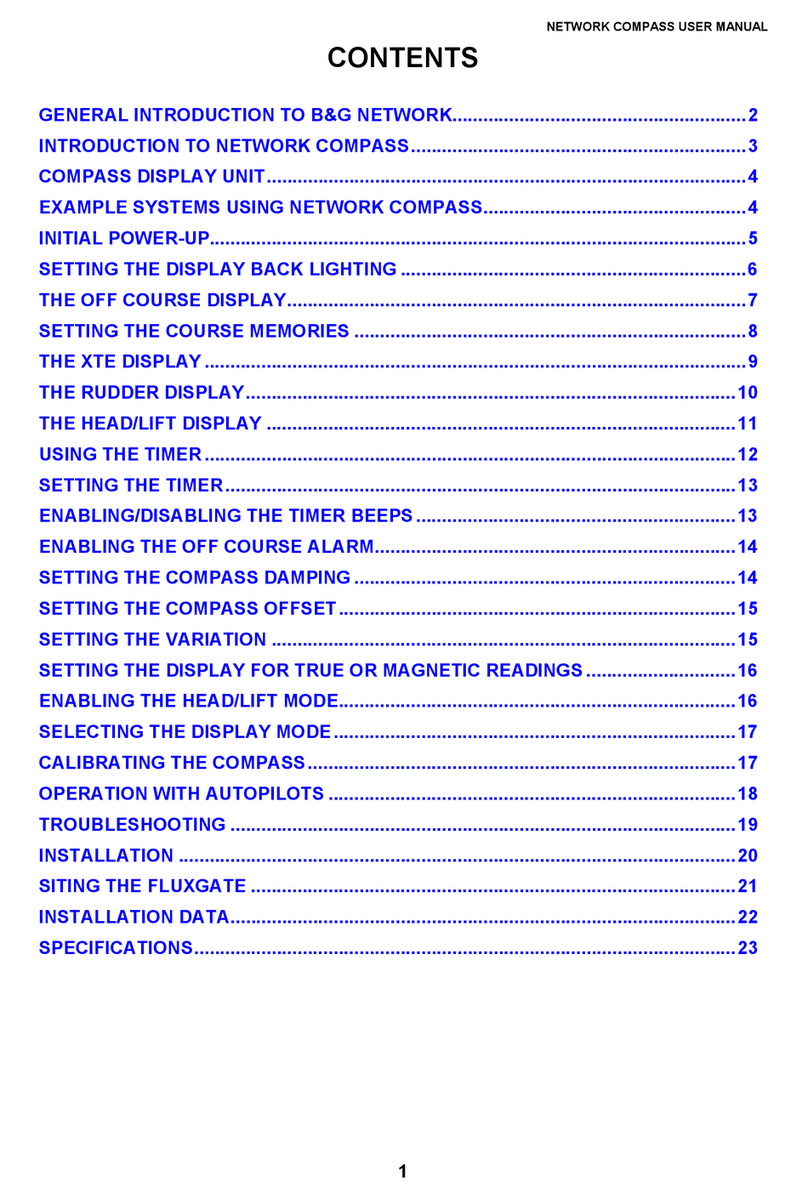
B&G Network
B&G Network Network System user manual

Riviera
Riviera ARTICA 2 3/4 user manual
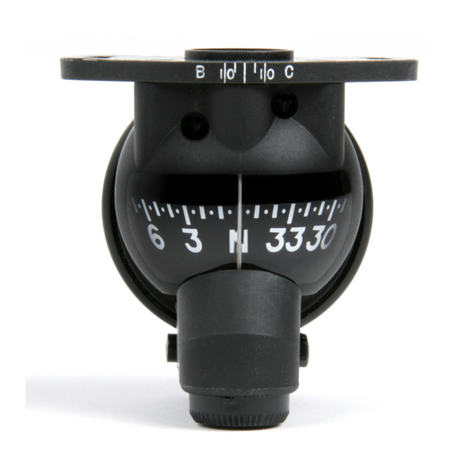
SIRS Navigation
SIRS Navigation KCA0101C COMPONENT MAINTENANCE MANUAL WITH ILLUSTRATED PARTS LIST
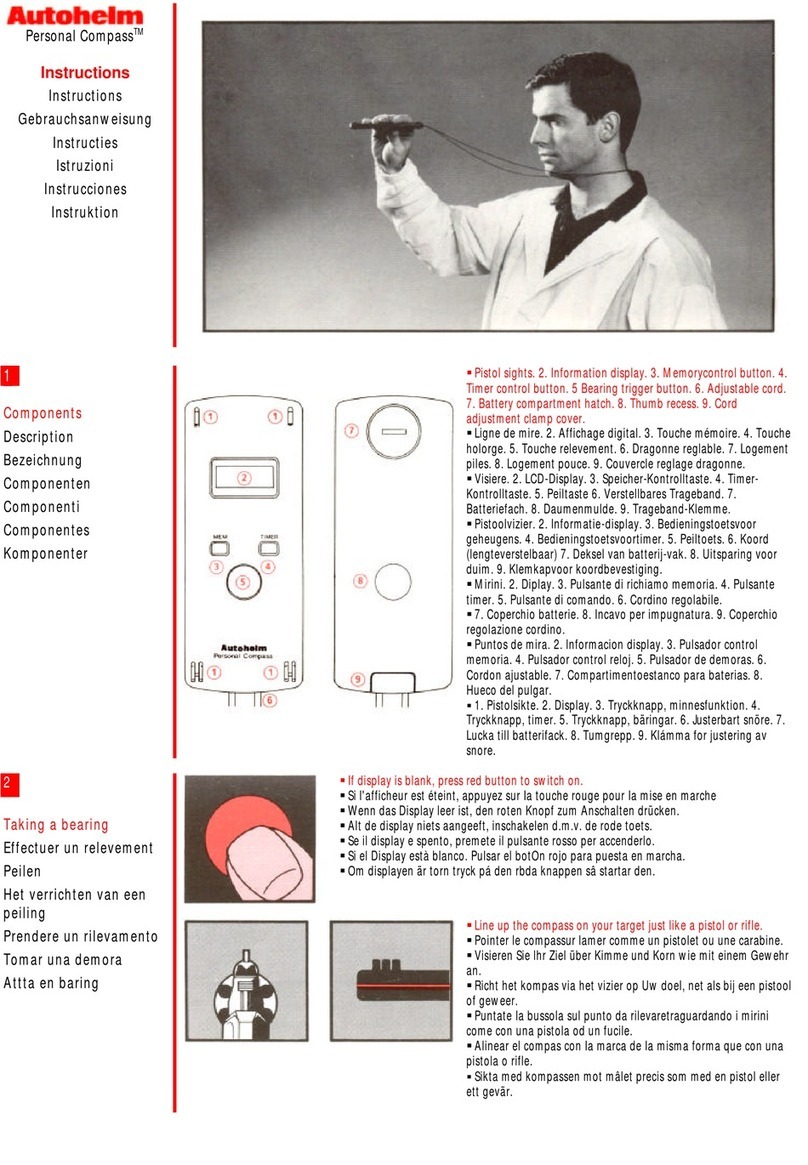
Raymarine
Raymarine Compass user guide
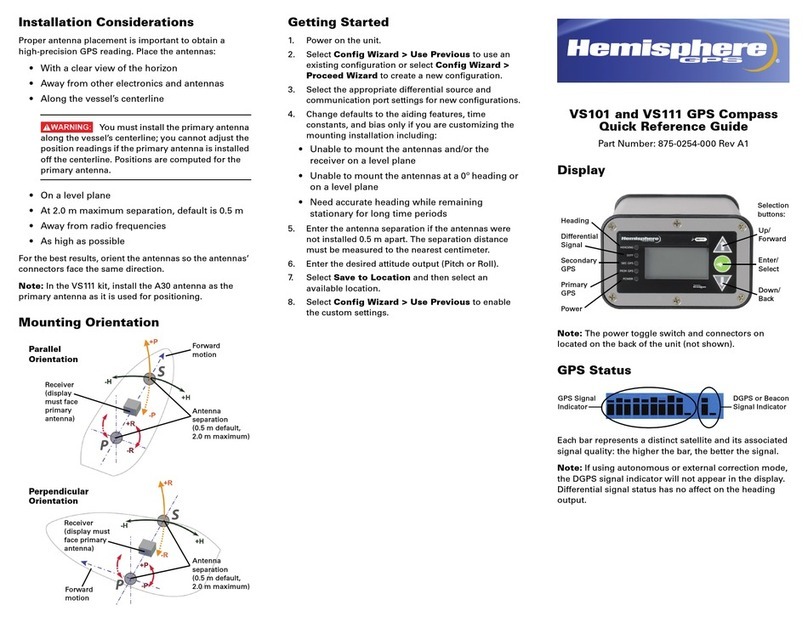
Hemisphere GPS
Hemisphere GPS VS101 Quick reference guide

